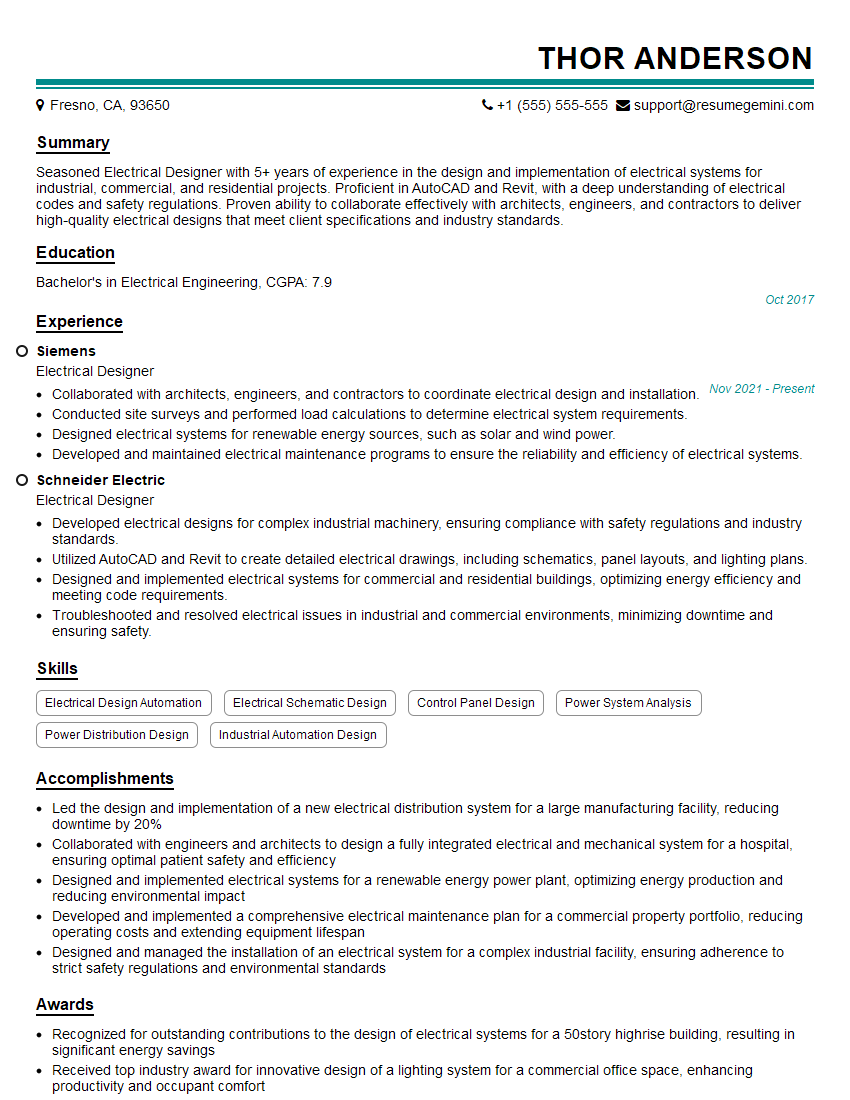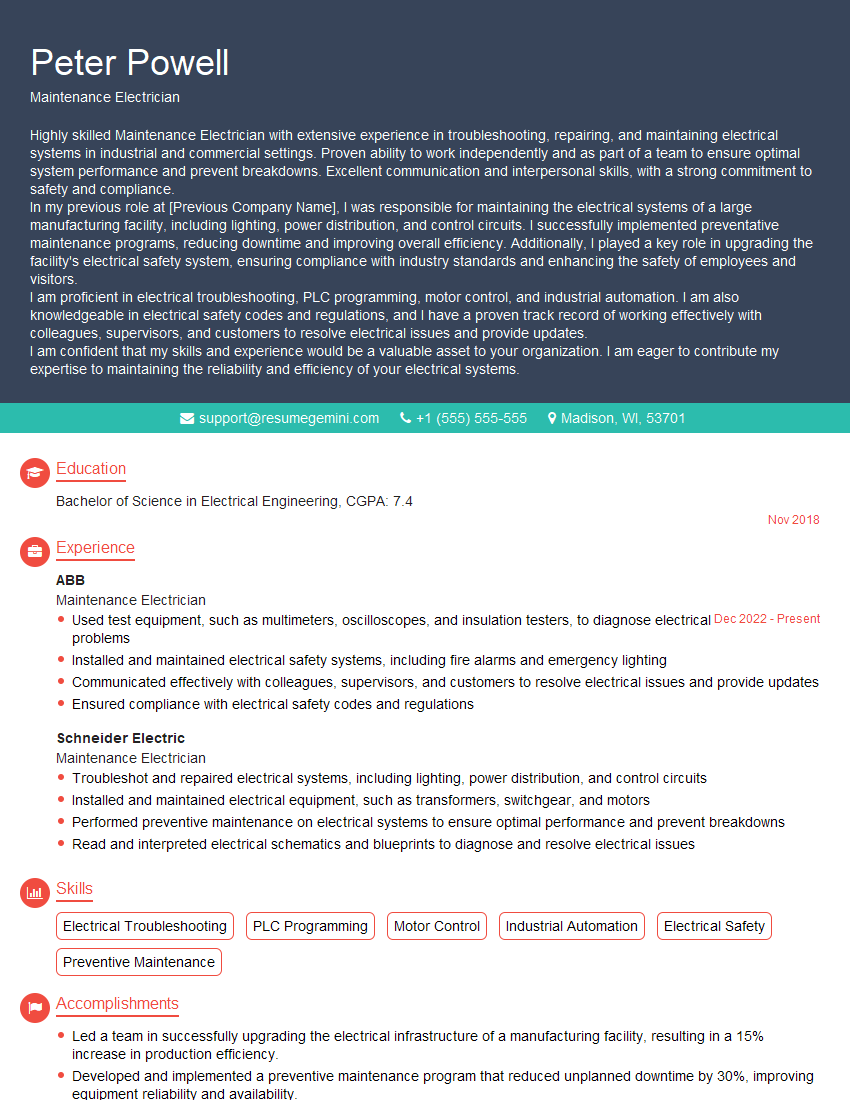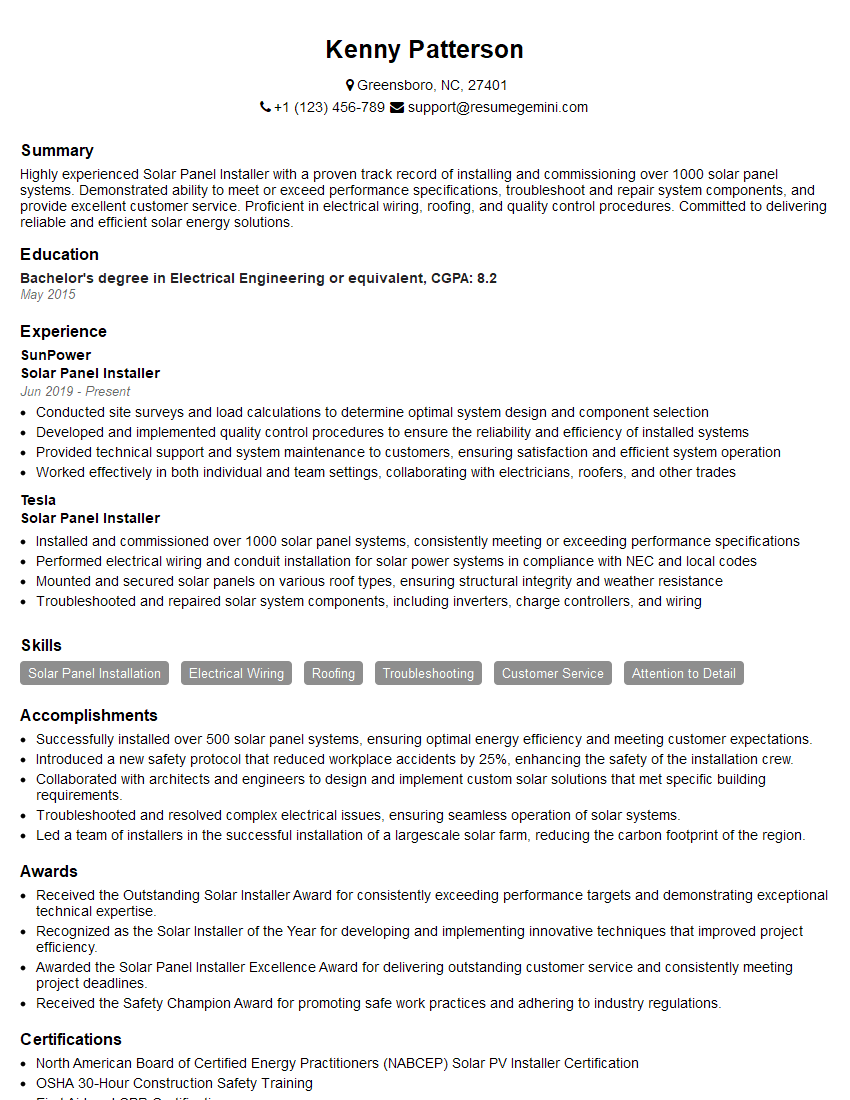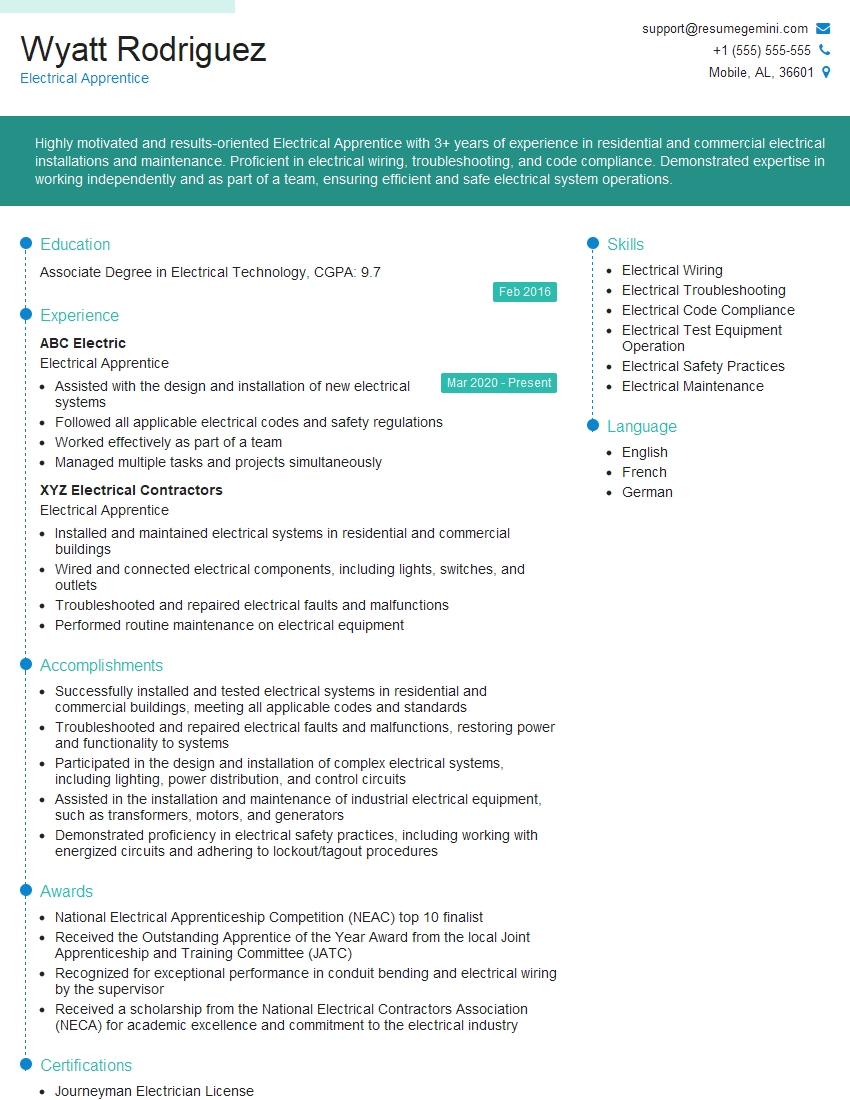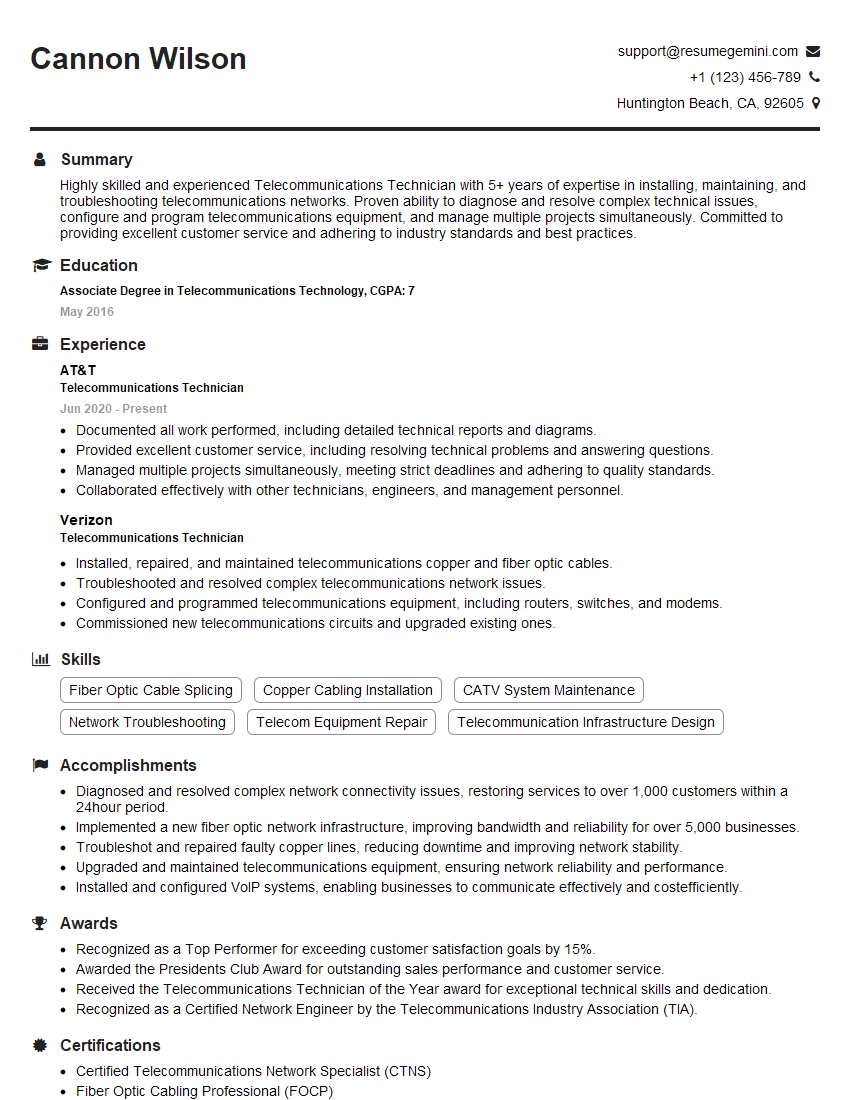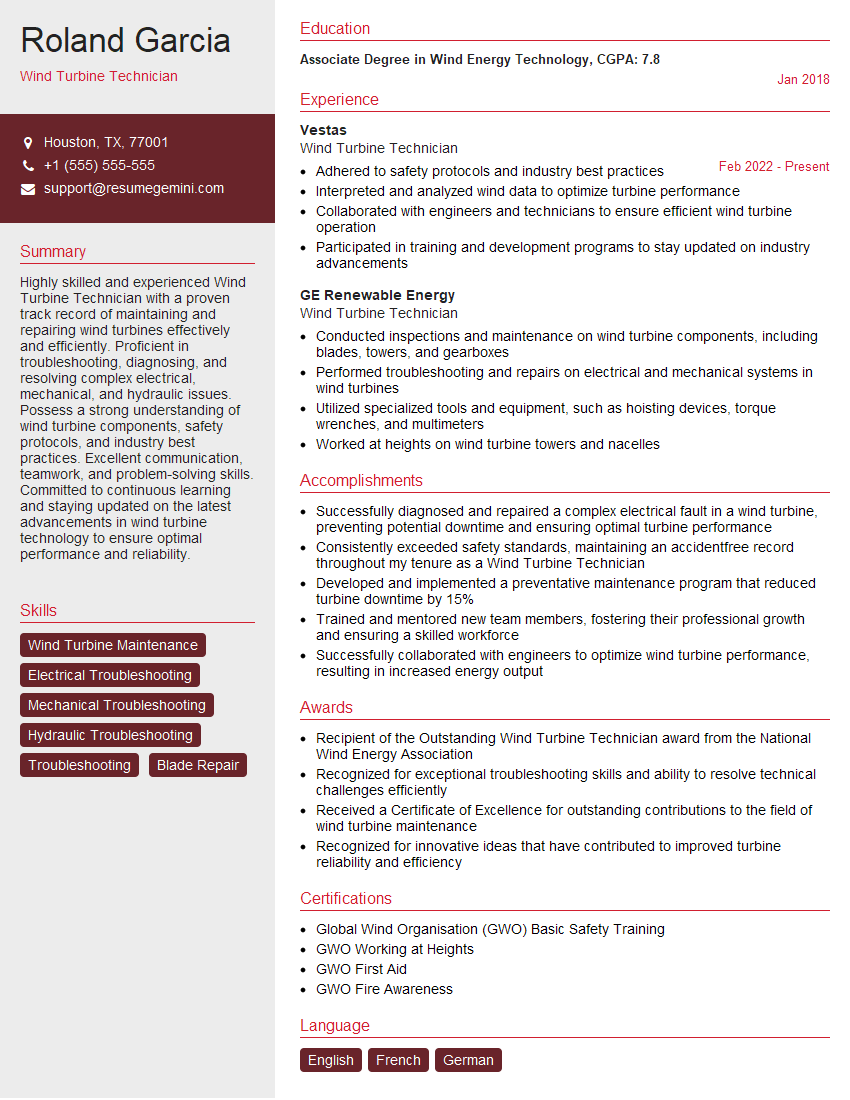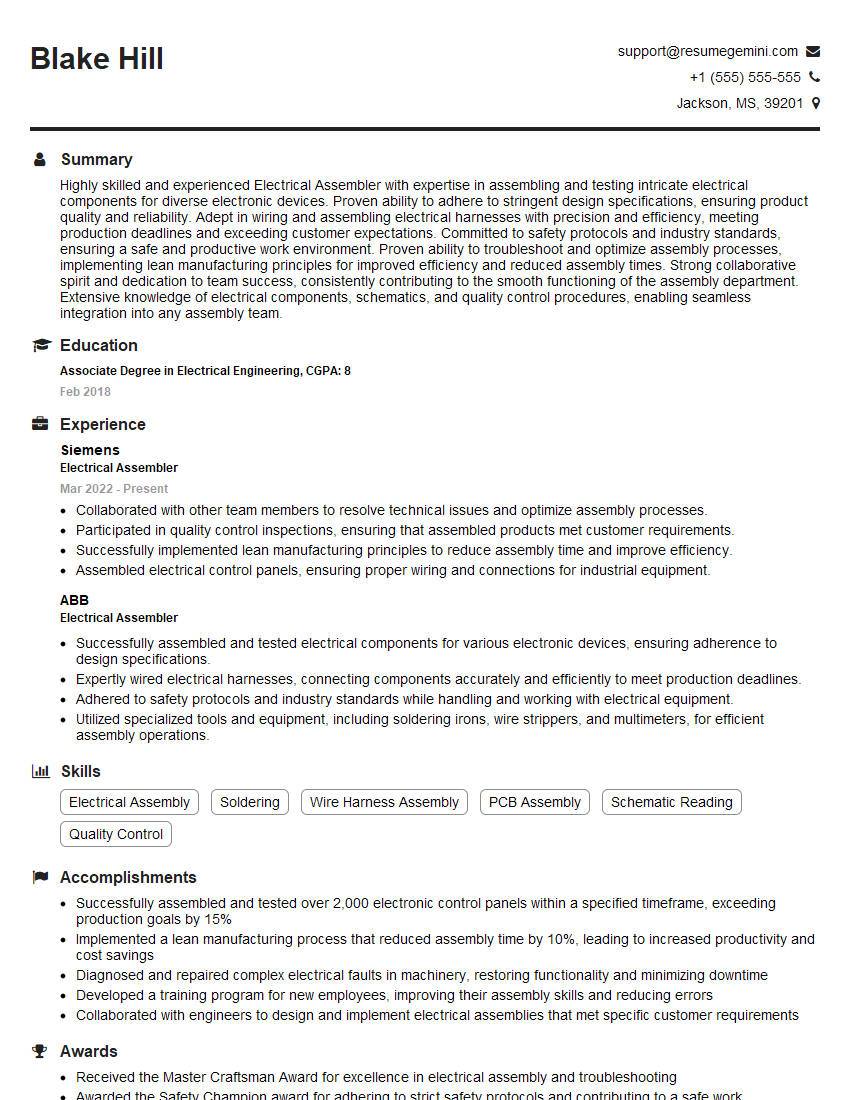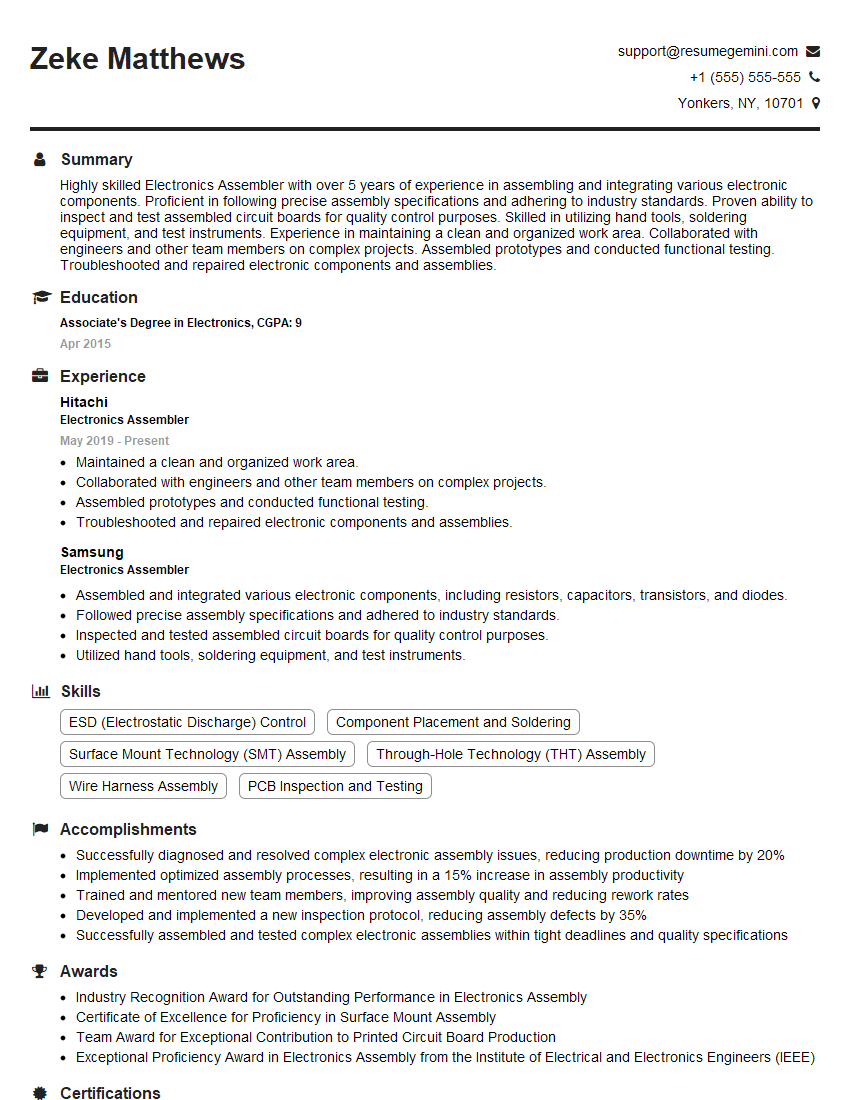The thought of an interview can be nerve-wracking, but the right preparation can make all the difference. Explore this comprehensive guide to Basic Stage Electric Theory interview questions and gain the confidence you need to showcase your abilities and secure the role.
Questions Asked in Basic Stage Electric Theory Interview
Q 1. What is Ohm’s Law and how is it applied in circuit analysis?
Ohm’s Law is a fundamental principle in electricity that describes the relationship between voltage (V), current (I), and resistance (R) in a circuit. It states that the voltage across a conductor is directly proportional to the current flowing through it, provided the temperature remains constant. Mathematically, it’s expressed as: V = IR.
In circuit analysis, Ohm’s Law is crucial for calculating any one of these three parameters if the other two are known. For instance, if you know the voltage across a resistor and its resistance, you can easily calculate the current flowing through it. This is essential for determining power dissipation in components, predicting circuit behavior, and troubleshooting malfunctions.
Example: A 10-ohm resistor has a voltage of 5 volts across it. Using Ohm’s Law (I = V/R), we find the current is 0.5 amps (0.5 A = 5 V / 10 Ω).
Q 2. Explain Kirchhoff’s Current Law (KCL) and Kirchhoff’s Voltage Law (KVL).
Kirchhoff’s Current Law (KCL): This law states that the algebraic sum of currents entering and leaving any node (junction) in a circuit is zero. Imagine a water pipe junction – the total amount of water flowing in must equal the total amount flowing out. In simpler terms, the current entering a node is equal to the current leaving the node.
Kirchhoff’s Voltage Law (KVL): This law states that the algebraic sum of voltages around any closed loop in a circuit is zero. Think of it like a roller coaster: the total rise in height must equal the total drop in height as you complete a full circuit. In other words, the sum of voltage drops across components in a closed loop is equal to the sum of voltage rises.
KCL and KVL are fundamental tools for analyzing complex circuits, allowing us to solve for unknown currents and voltages using simultaneous equations. They are particularly helpful when dealing with circuits that have multiple loops and branches.
Q 3. Define resistance, inductance, and capacitance. How do they behave in AC and DC circuits?
Resistance (R): Resistance is the opposition to the flow of electric current. It’s measured in ohms (Ω). In DC circuits, resistance is constant for a given resistor. In AC circuits, resistance can be more complex and includes reactance (discussed below). Think of it as friction in a water pipe – higher friction (resistance) means less water flow (current).
Inductance (L): Inductance is the property of a circuit element (typically a coil) that opposes changes in current. It stores energy in a magnetic field. In DC circuits, once the current stabilizes, the inductor acts like a short circuit. However, in AC circuits, the inductor’s impedance increases with frequency, because it opposes the constantly changing current. This impedance is called inductive reactance (XL).
Capacitance (C): Capacitance is the ability of a circuit element (typically two conductive plates separated by an insulator) to store electrical energy in an electric field. In DC circuits, once fully charged, a capacitor acts as an open circuit. In AC circuits, its impedance decreases with frequency, meaning it opposes changes in voltage. This impedance is called capacitive reactance (XC).
Q 4. What are the different types of resistors and their applications?
Resistors come in various types, each with specific characteristics and applications:
- Carbon Film Resistors: Inexpensive, widely used, good for general-purpose applications.
- Metal Film Resistors: More precise and stable than carbon film resistors, suitable for applications requiring higher accuracy.
- Wirewound Resistors: High power handling capability, used in applications requiring high wattage dissipation.
- Variable Resistors (Potentiometers): Allow for adjustable resistance, commonly used for volume control in audio equipment.
The choice of resistor depends on the specific requirements of the circuit, including power dissipation, tolerance, and temperature stability.
Q 5. Describe the different types of capacitors and their applications.
Capacitors also come in various forms:
- Ceramic Capacitors: Small, inexpensive, widely used in electronic circuits.
- Film Capacitors: Offer better stability and higher capacitance values than ceramic capacitors, often used in audio and filtering applications.
- Electrolytic Capacitors: Have high capacitance values for their size, but are polarized (must be connected with correct polarity), typically used in power supplies and filtering.
- Variable Capacitors: Allow for adjustable capacitance, used for tuning circuits in radios and other applications.
The selection of a capacitor is driven by factors like capacitance value, voltage rating, temperature stability, and application requirements. For instance, electrolytic capacitors are crucial in power supplies for smoothing out pulsating DC.
Q 6. What is the difference between series and parallel circuits?
Series Circuit: In a series circuit, components are connected end-to-end, forming a single path for current flow. The current is the same through all components, but the voltage is divided across them. Imagine a single lane road – all cars travel the same path.
Parallel Circuit: In a parallel circuit, components are connected across each other, providing multiple paths for current flow. The voltage is the same across all components, but the current is divided among them. Think of a multi-lane highway – cars can travel different paths.
Q 7. How do you calculate total resistance in series and parallel circuits?
Series Circuit: The total resistance (RT) in a series circuit is the sum of the individual resistances: RT = R1 + R2 + R3 + ...
Parallel Circuit: The total resistance (RT) in a parallel circuit is calculated using the reciprocal formula:
1/RT = 1/R1 + 1/R2 + 1/R3 + ...
For only two resistors in parallel, a simpler formula can be used: RT = (R1 * R2) / (R1 + R2)
Understanding these calculations is vital for designing circuits and ensuring components operate within their safe limits. Incorrect calculations can lead to component failure or circuit malfunction.
Q 8. Explain the concept of impedance.
Impedance is the opposition to the flow of current in an AC circuit. Unlike resistance in DC circuits, which only considers the opposition from the material’s properties, impedance in AC circuits also accounts for the effects of capacitance and inductance. Think of it as the total resistance, encompassing not just the ‘friction’ of the material but also the energy storage effects of capacitors and inductors.
It’s measured in ohms (Ω) and is a complex number, represented as Z = R + jX, where R is the resistance (in ohms), X is the reactance (in ohms), and j is the imaginary unit (√-1). Reactance (X) is further divided into inductive reactance (XL) and capacitive reactance (XC). XL = 2πfL (where f is frequency and L is inductance) and XC = 1/(2πfC) (where C is capacitance). The total impedance depends on the frequency of the AC signal.
Example: Imagine a circuit with a 10Ω resistor and a 5Ω inductive reactance. The impedance would be Z = 10 + j5 Ω. This means the circuit offers 10Ω of resistive opposition and 5Ω of inductive opposition to the current flow.
Q 9. What is a phasor and how is it used in AC circuit analysis?
A phasor is a rotating vector used to represent a sinusoidal (sine or cosine) waveform. It simplifies AC circuit analysis by representing the amplitude and phase angle of a sinusoidal signal as a single vector. The length of the phasor represents the amplitude, and the angle it makes with the positive real axis represents the phase angle.
In AC circuit analysis, we use phasors to add and subtract sinusoidal quantities easily. Instead of dealing with trigonometric functions directly, we use vector addition and subtraction in the complex plane. This significantly simplifies calculations involving multiple sinusoidal waveforms with different phases and amplitudes.
Example: Two voltage sources, V1 = 10sin(ωt) and V2 = 5sin(ωt + π/3), can be represented as phasors. V1 would be a phasor of length 10 at 0° and V2 would be a phasor of length 5 at 60°. To find the resultant voltage, we perform vector addition of these phasors in the complex plane.
Q 10. How do you calculate power in AC and DC circuits?
Power calculation differs significantly between AC and DC circuits due to the presence of phase differences in AC.
- DC Circuits: Power is simply the product of voltage and current: P = VI (Watts). It’s a constant value.
- AC Circuits: Due to the sinusoidal nature of AC, we have different types of power:
- Apparent Power (S): This is the product of the RMS (Root Mean Square) voltage and current: S = VI (Volt-Amperes or VA). It represents the total power supplied to the circuit.
- Real Power (P): This is the actual power consumed by the resistive components and is given by P = VIcosθ (Watts), where θ is the phase angle between voltage and current.
- Reactive Power (Q): This is the power exchanged between the inductive and capacitive components and is given by Q = VIsinθ (Volt-Ampere Reactive or VAR). It doesn’t contribute to actual work done.
Example: In an AC circuit with V = 120V RMS, I = 5A RMS, and a phase angle of 30°, the apparent power is S = 600 VA, the real power is P = 600cos(30°) ≈ 520 W, and the reactive power is Q = 600sin(30°) = 300 VAR.
Q 11. What is power factor and why is it important?
Power factor (PF) is the cosine of the phase angle (θ) between the voltage and current in an AC circuit: PF = cosθ. It represents the ratio of real power to apparent power: PF = P/S.
A power factor of 1 indicates perfect alignment of voltage and current (purely resistive load), meaning all apparent power is converted to real power. A lower power factor (less than 1) indicates a significant phase difference, implying a larger portion of the apparent power is reactive and doesn’t contribute to useful work. This leads to higher current flow for the same real power, resulting in increased line losses and potentially requiring larger equipment.
Importance: Maintaining a high power factor is crucial for efficient power utilization. Utilities often charge penalties for low power factors because they require more capacity to deliver the same amount of real power. Power factor correction techniques, such as adding capacitors to the circuit, are often used to improve the power factor.
Q 12. Explain the concept of resonance in AC circuits.
Resonance in an AC circuit occurs when the inductive reactance (XL) and capacitive reactance (XC) cancel each other out. This happens at a specific frequency, called the resonant frequency (fr). At resonance, the impedance of the circuit is purely resistive (Z = R), resulting in a maximum current flow for a given voltage.
The resonant frequency is given by the formula: fr = 1/(2π√LC), where L is inductance and C is capacitance.
Example: A series RLC circuit (resistor, inductor, and capacitor in series) will exhibit resonance. At the resonant frequency, the current will be at its maximum, and the voltage across the inductor and capacitor will be equal in magnitude but opposite in phase.
Resonance is exploited in various applications, including radio tuning circuits where the circuit is tuned to resonate at the desired radio frequency, filtering out other frequencies.
Q 13. What are the different types of transformers and their applications?
Transformers are static devices that transfer electrical energy between circuits through electromagnetic induction. They are primarily used to step up (increase) or step down (decrease) voltage levels.
- Step-up Transformer: The number of turns in the secondary coil (output) is greater than the number of turns in the primary coil (input). It increases the voltage but decreases the current.
- Step-down Transformer: The number of turns in the secondary coil is less than the number of turns in the primary coil. It decreases the voltage but increases the current.
- Isolation Transformer: This type of transformer provides electrical isolation between the input and output circuits, preventing ground loops and protecting sensitive equipment.
- Autotransformer: This transformer uses a single coil with a tap to provide multiple voltage levels.
Applications: Transformers are ubiquitous. Power transmission uses step-up transformers to transmit power at high voltage and low current (reducing losses) over long distances. Step-down transformers then reduce the voltage to safe levels for household and industrial use. They are also essential components in electronic devices, power supplies, and many other applications.
Q 14. Explain the working principle of a simple DC motor.
A simple DC motor works based on the principle of electromagnetic force. When a current-carrying conductor is placed in a magnetic field, it experiences a force. A DC motor essentially utilizes this force to create rotational motion.
The motor consists of a rotor (armature) with windings that carry current and a stator (stationary part) with magnets that create a magnetic field. When a current flows through the rotor windings, the interaction between the magnetic field of the stator and the magnetic field generated by the rotor windings produces a torque on the rotor, causing it to rotate. A commutator, which is a rotating switch, ensures that the current in the rotor windings changes direction at the right time to maintain continuous rotation.
Simplified Explanation: Imagine a loop of wire placed between two magnets. When you pass a current through the wire, it will experience a force from the magnets. By cleverly switching the direction of the current at the right times (using the commutator), you can maintain the rotational motion of the loop.
Q 15. What are the different types of batteries and their characteristics?
Batteries are electrochemical devices that convert chemical energy into electrical energy. Several types exist, each with unique characteristics affecting their applications.
- Primary (Single-Use) Batteries: These are disposable and cannot be recharged. Examples include zinc-carbon and alkaline batteries. Zinc-carbon batteries are inexpensive but have a lower energy density and shorter shelf life. Alkaline batteries offer higher energy density and longer shelf life, making them suitable for devices requiring longer operation.
- Secondary (Rechargeable) Batteries: These can be recharged multiple times. Common examples include lead-acid, nickel-cadmium (NiCd), nickel-metal hydride (NiMH), and lithium-ion (Li-ion) batteries. Lead-acid batteries are heavy but inexpensive and provide high current output, ideal for car batteries. NiCd and NiMH batteries are lightweight and rechargeable, but NiCd suffers from the memory effect (reduced capacity if not fully discharged). Li-ion batteries offer high energy density, long cycle life, and lightweight design, making them ubiquitous in portable electronics.
The choice of battery depends on factors like cost, required energy density, discharge rate, lifespan, and environmental concerns. For instance, a toy might use an alkaline battery for its affordability and longevity, while an electric vehicle relies on the high energy density of lithium-ion batteries.
Career Expert Tips:
- Ace those interviews! Prepare effectively by reviewing the Top 50 Most Common Interview Questions on ResumeGemini.
- Navigate your job search with confidence! Explore a wide range of Career Tips on ResumeGemini. Learn about common challenges and recommendations to overcome them.
- Craft the perfect resume! Master the Art of Resume Writing with ResumeGemini’s guide. Showcase your unique qualifications and achievements effectively.
- Don’t miss out on holiday savings! Build your dream resume with ResumeGemini’s ATS optimized templates.
Q 16. What are the safety precautions to be followed while working with electricity?
Working with electricity can be dangerous; therefore, safety precautions are paramount.
- Always de-energize circuits before working on them: This involves turning off the breaker or removing the fuse. Never assume a circuit is de-energized; always verify with a voltage tester.
- Use insulated tools and equipment: This minimizes the risk of electrical shock. Insulated screwdrivers, pliers, and voltage testers are crucial.
- Wear appropriate personal protective equipment (PPE): This includes safety glasses to protect your eyes, rubber gloves to insulate your hands, and safety shoes to protect against electrical hazards.
- Work in a well-lit and dry area: Avoid working in wet conditions, as water can conduct electricity and increase the risk of shock.
- Never work alone: Having a partner nearby allows for assistance in case of an emergency.
- Understand the electrical system before working on it: Familiarize yourself with the circuit diagrams and the potential hazards involved.
Ignoring safety measures can lead to severe consequences, including electrical shock, burns, fires, and even death. Safety should always be the top priority when working with electricity.
Q 17. What are the different types of electrical wiring methods?
Several methods exist for electrical wiring, each with its applications and advantages.
- Knob-and-tube wiring: An older method using porcelain knobs and tubes to support and insulate wires. It’s rarely used in new construction due to its fire hazard potential.
- Romex (non-metallic sheathed cable): A common wiring method using plastic-sheathed cables containing multiple insulated conductors. Easy to install and cost-effective.
- Conduit wiring: Wires are run inside metal or plastic pipes called conduits, offering excellent protection against physical damage and fire. Often used in industrial settings or where durability is critical.
- Surface mount wiring: Wires are run along the surface of walls or ceilings using surface raceways or molding. Suitable for renovations or where running wires through walls is impractical.
The choice of wiring method depends on factors such as building codes, budget, the type of building, and the application. For example, conduit wiring is preferred in commercial buildings for its durability and fire protection, while Romex is commonly used in residential buildings for its ease of installation.
Q 18. Explain the use of fuses and circuit breakers.
Fuses and circuit breakers are safety devices that protect electrical circuits from overcurrent, preventing damage to equipment and reducing fire hazards.
Fuses: A fuse contains a thin wire that melts and breaks the circuit if the current exceeds a certain value. Once blown, it needs replacement. They are simple and inexpensive but are one-time use devices.
Circuit Breakers: These are automatic switches that trip (open) when the current exceeds a preset value. They can be reset after tripping, making them reusable and more convenient than fuses. Circuit breakers offer better protection and are more easily reset.
Both fuses and circuit breakers are essential for electrical safety. Think of them as guardians of your electrical system, preventing catastrophic failures. For instance, a short circuit in a lighting circuit would trigger the circuit breaker, preventing a fire.
Q 19. How do you read electrical schematics and wiring diagrams?
Electrical schematics and wiring diagrams are visual representations of electrical circuits. Understanding these diagrams is crucial for troubleshooting and installation.
Schematics: Use standardized symbols to represent components and their connections, showing the logical flow of electricity without necessarily showing the physical layout. They are useful for understanding the overall circuit function.
Wiring Diagrams: Show the physical layout of the components and wires, indicating how they are interconnected. They are useful for installation and troubleshooting physical wiring problems.
Reading these diagrams requires familiarity with standard electrical symbols. For instance, a circle with a cross inside typically represents a resistor, while a straight line with a circle at each end commonly represents a battery. Following the lines and symbols helps trace the path of electricity through the circuit. Learning to interpret these symbols and follow the flow of current is essential for anyone working with electrical systems.
Q 20. What is grounding and why is it important?
Grounding is the process of connecting an electrical system to the earth. This connection provides a path for fault currents to flow safely to the ground, preventing dangerous voltages from appearing on conductive surfaces.
Importance of Grounding:
- Safety: If a fault occurs (e.g., a short circuit), the ground wire provides a low-resistance path for the current to flow to the earth, preventing dangerous voltages from appearing on the metal casing of appliances or equipment. This drastically reduces the risk of electric shock.
- Protection of Equipment: Grounding protects sensitive electronic components from voltage surges and other electrical disturbances.
- Fire Prevention: Grounding helps prevent electrical fires by providing a path for fault currents, reducing the chance of overheating and sparking.
Imagine grounding as a safety net; if something goes wrong, the current is safely diverted to the ground instead of causing harm. A properly grounded system is vital for both safety and equipment protection.
Q 21. Explain the concept of short circuit and open circuit.
Short circuits and open circuits are two common electrical faults.
Short Circuit: A short circuit occurs when an unintended low-resistance path is created between two points in a circuit with different potentials. This results in a very high current flow, potentially causing overheating, fire, and damage to equipment. Imagine a short circuit as an unintended shortcut for the electricity, bypassing the intended path.
Open Circuit: An open circuit occurs when there’s a break in the electrical path, preventing current from flowing. This can be due to a broken wire, a faulty component, or a disconnected switch. Think of an open circuit as a roadblock, stopping the flow of electricity.
Both short circuits and open circuits can disrupt the operation of electrical systems. Identifying and correcting these faults requires careful inspection and troubleshooting techniques using multimeters and other testing equipment.
Q 22. What is a multimeter and how do you use it?
A multimeter is a versatile handheld instrument used to measure various electrical properties. Think of it as a Swiss Army knife for electricians – it can measure voltage (the electrical pressure), current (the flow of electricity), and resistance (opposition to current flow). It usually also has a continuity tester to check for unbroken circuits.
To use a multimeter, first select the appropriate function (voltage, current, resistance, etc.) using the dial. Then, select the appropriate range; starting with a higher range and working down prevents damage to the meter. Connect the probes – typically red for positive and black for negative – to the circuit according to the instructions. For voltage measurements, connect the probes across the component; for current measurements, connect the probes in series with the component; for resistance measurements, ensure the circuit is de-energized before connecting the probes across the component. Always refer to the multimeter’s manual for specific instructions and safety precautions.
Example: To measure the voltage across a battery, set the multimeter to DC voltage, select an appropriate range (e.g., 20V), connect the red probe to the positive terminal and the black probe to the negative terminal. The reading displayed is the battery voltage.
Q 23. Describe different types of electrical measuring instruments.
Electrical measuring instruments are crucial for understanding and troubleshooting circuits. They can be broadly categorized as:
- Ammeters: Measure electric current (amps). They are connected in series with the circuit component.
- Voltmeters: Measure electric potential difference (volts). They are connected in parallel across the component.
- Ohmmeters: Measure electrical resistance (ohms). The circuit must be de-energized before measurement.
- Multimeters: Combine the functions of ammeters, voltmeters, and ohmmeters in a single device (as discussed above).
- Clamp meters: Measure current without breaking the circuit, using a clamp around the wire.
- Wattmeters: Measure electrical power (watts).
- Oscilloscope: Displays the waveform of electrical signals, showing voltage changes over time. This is invaluable for analyzing AC signals.
Each instrument has a specific application, and choosing the right one is essential for accurate measurements and safe practices.
Q 24. What are the different types of AC and DC generators?
AC (alternating current) and DC (direct current) generators differ fundamentally in the type of output current they produce.
- DC Generators: These generators produce a unidirectional current. Common types include:
- Separately excited generators: The field winding is excited by a separate DC source.
- Self-excited generators: The field winding is excited by the generator’s own output.
- Series-wound generators: The field winding is connected in series with the armature.
- Shunt-wound generators: The field winding is connected in parallel with the armature.
- Compound-wound generators: Combine series and shunt windings.
- AC Generators (Alternators): Produce an alternating current that periodically reverses direction. The most common type is the synchronous alternator, where the frequency of the output voltage is directly proportional to the rotational speed of the generator.
The choice between AC and DC generators depends on the application. DC generators are often used in applications requiring stable DC power, while AC generators are more common in power generation and distribution due to their efficient transmission capabilities.
Q 25. Explain the principle of operation of a simple relay.
A simple relay is an electromechanical switch that uses a small electrical current to control a much larger current. Think of it as an electrically controlled on/off switch.
It operates on the principle of electromagnetism. A coil of wire, called the electromagnet, is connected to a low-voltage control circuit. When current flows through the coil, it generates a magnetic field. This field attracts a ferromagnetic armature, which is mechanically linked to a set of contacts. The armature’s movement closes or opens the contacts in the main power circuit, switching the high-voltage or high-current load on or off. The low-voltage control circuit can easily be controlled by a microcontroller or a simple switch, while the relay can handle the heavy load.
Example: In a home automation system, a low-voltage signal from a microcontroller might activate a relay to control a high-power light fixture. The relay isolates the microcontroller from the high voltage of the light, preventing damage.
Q 26. What is a PLC (Programmable Logic Controller) and its applications?
A PLC (Programmable Logic Controller) is a digital computer used for automation of electromechanical processes, such as control of machinery on factory assembly lines. It’s a robust and reliable system designed for industrial environments.
PLCs are programmed using ladder logic, a graphical programming language easy to understand for those familiar with relay logic. They have input modules that read signals from sensors and output modules that control actuators (motors, solenoids, etc.). The PLC’s central processing unit (CPU) executes the program to control the process based on the input signals.
Applications: PLCs are used in a wide range of applications, including:
- Industrial automation: Controlling assembly lines, robotic arms, and other manufacturing equipment.
- Building automation: Controlling HVAC systems, lighting, and security systems.
- Process control: Monitoring and controlling chemical processes, water treatment plants, and power plants.
- Traffic signal control.
Q 27. How do you troubleshoot simple electrical circuits?
Troubleshooting simple electrical circuits involves a systematic approach to identify and fix faults. A common method is:
- Visual Inspection: Check for any obvious problems like loose connections, burnt components, or damaged wires.
- Testing with a Multimeter: Use a multimeter to measure voltage, current, and resistance at various points in the circuit. Compare the measurements with the expected values based on the circuit diagram.
- Continuity Test: Use the continuity test on the multimeter to check for broken wires or components.
- Systematic Elimination: Isolate sections of the circuit and test each part to pinpoint the faulty component. Replace or repair any damaged parts.
- Verification: Once a fix is implemented, retest the circuit to ensure the problem is resolved and the circuit functions correctly. Observe the system’s behavior to confirm its stability.
Example: If a light bulb doesn’t turn on, first check if the bulb is burnt. Then, check the voltage at the socket using a multimeter. If no voltage is present, trace the wiring back to the switch and check for continuity. The problem could be a faulty switch, a broken wire, or a tripped breaker.
Q 28. Describe your experience with electrical codes and safety standards.
Throughout my career, I’ve adhered strictly to relevant electrical codes and safety standards. I’m familiar with the National Electrical Code (NEC) in the US and other international standards, such as IEC standards. I understand the importance of proper grounding, wire sizing, overcurrent protection (fuses and circuit breakers), and lockout/tagout procedures for preventing electrical hazards. I’ve worked on projects requiring adherence to specific safety regulations, always prioritizing safety during design, installation, and maintenance. I’ve personally conducted safety training for colleagues, emphasizing the risks associated with working with electricity and the importance of preventive measures. My experience includes ensuring all work complies with relevant codes and standards, leading to safe and reliable electrical systems. I’m committed to maintaining a safe working environment and abiding by all relevant regulations.
Key Topics to Learn for Basic Stage Electric Theory Interview
- Ohm’s Law and Circuit Analysis: Understanding voltage, current, and resistance, and their relationships within simple and complex circuits. Practical application: Troubleshooting basic electrical circuits and calculating power dissipation.
- DC Circuits: Series and parallel circuits, Kirchhoff’s laws, and analyzing voltage and current distribution. Practical application: Designing simple DC power supplies and understanding circuit behavior.
- AC Circuits: Introduction to alternating current, waveforms (sine wave, etc.), frequency, and the concept of impedance. Practical application: Understanding basic AC circuits and their applications in power systems.
- Basic Electrical Components: Understanding the function and characteristics of resistors, capacitors, inductors, diodes, and transistors. Practical application: Identifying components in a circuit diagram and predicting their behavior.
- Electrical Safety: Understanding common hazards associated with electricity and safety precautions. Practical application: Safe work practices in electrical environments.
- Magnetism and Electromagnetism: Fundamental principles of magnetism and how it relates to electricity (electromagnetism). Practical application: Understanding the operation of simple electric motors and generators.
- Power and Energy Calculations: Calculating power and energy consumption in electrical circuits. Practical application: Designing energy-efficient electrical systems.
Next Steps
Mastering Basic Stage Electric Theory is crucial for a successful career in many electrical and related fields. A strong understanding of these fundamentals will open doors to exciting opportunities and allow you to confidently tackle complex challenges. To maximize your job prospects, creating a well-structured, ATS-friendly resume is vital. ResumeGemini is a trusted resource that can help you build a professional and impactful resume tailored to your skills and experience. We provide examples of resumes specifically designed for candidates with expertise in Basic Stage Electric Theory to help you get started. Invest the time in crafting a compelling resume – it’s your first impression with potential employers.
Explore more articles
Users Rating of Our Blogs
Share Your Experience
We value your feedback! Please rate our content and share your thoughts (optional).
What Readers Say About Our Blog
This was kind of a unique content I found around the specialized skills. Very helpful questions and good detailed answers.
Very Helpful blog, thank you Interviewgemini team.
